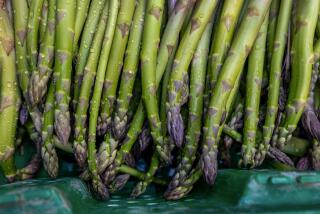Sells Snails to Canner : Citrus Grower Turns Pests Into Escargot
- Share via
OJAI — Snail ranching. The possibilities are enough to set a man’s mind to racing.
Do snail ranch hands, for instance, whistle and holler, “C’mon, little doggies”? And a snail’s got to be tough to rope.
Another thing: At roundup, those horses must wipe out half the herd, what with all those hoofs smashing down on those delicate brown shells.
Laugh all you want. Ojai snail rancher Chuck Whipple does. He laughs all the way to the bank.
Recently the Great Taste Newsletter of New York City held a blind tasting of canned escargot from all over the world. It picked the Ojai snails over snails from France, Belgium, Germany and the Orient.
Normally, snails that damage citrus crops are a lemon rancher’s worst enemy. And Whipple manages more than 240 acres of citrus for Ojai Land Co.
Whipple was doing all he could to fight the snails without poison baits. He tried using various traps.
“We did everything,” Whipple’s wife, Lynn, said. “When it rained, Chuck, the kids and I, we all got on our rubber boots and said, ‘Let’s go stomping snails.’
“Now, of course, it’s, ‘Hey, be careful.’ In fact, I kind of like snails now, except they hurt my flowers.”
Whipple finally banded his trees with strips of copper to keep the snails away. His trees were safe, but there were still snails around, thriving on leaves and fruit that dropped off the trees.
More Snails Than Ever
“There were still snails around--tons of them, more than ever,” Whipple said. “But they weren’t hurting the fruit. Our problems were solved.”
It was at this point that Mike Beyries of Petaluma showed up.
Beyries and partner Tracy Brash own the only U.S. Department of Agriculture-approved escargot canning plant in the Northern Hemisphere. Under the Enfant Riant label (French for “laughing child”), they annually ship 96,000 pounds of canned California snails all over the world, into every snail-eating nation except France.
“Our dream is, of course, to export to France someday,” Beyries said. “It would be like selling them California wine.”
Deal With Tree-Strip Maker
Beyries had a deal going with the people who manufacture and sell the copper tree strips. He wanted the names of anyone buying large quantities of these strips, because the chances were they were fighting off hordes of snails.
Whipple said Beyries’ proposal made sense.
Said Beyries: “What we want to do is convince citrus ranchers that snails are not a pest, but a secondary crop.”
“We have a little saying,” he said. “Snails are one of the few crops that try to run away from you. But, luckily, they don’t run very fast.”
Two years ago, Whipple figured that if he shipped 700 pounds of snails in a month he was doing great business. Nowadays, 8,000 pounds of snails is a fair-to-middling shipment.
Hard to Recruit Pickers
The biggest obstacle to gathering snails, however, was persuading people to get on their hands and knees and pick the critters. Professional farm workers felt it was below their station. But as they realize the money that can be made--50 cents a pound--that is changing.
For a while Whipple depended on schools and charities, which would pick snails to earn money for various causes.
The rowing team from the University of California, Santa Barbara, earned enough money picking snails to buy an expensive rowing shell.
Whipple now has a small cadre of pickers, mostly wives of ranch hands.
And yet Whipple has never eaten one of his herd. “One of these days I’ll get around to it,” he said. “All the French chefs say a snail’s where it’s at. But I don’t know.”
More to Read
Inside the business of entertainment
The Wide Shot brings you news, analysis and insights on everything from streaming wars to production — and what it all means for the future.
You may occasionally receive promotional content from the Los Angeles Times.










